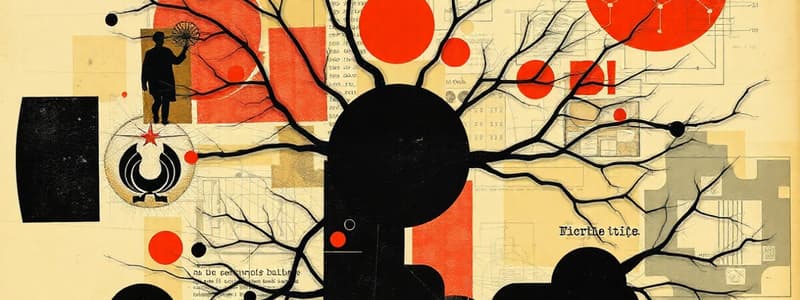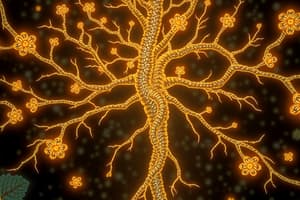Podcast
Questions and Answers
What type of receptors do muscarinic antagonists primarily affect?
What type of receptors do muscarinic antagonists primarily affect?
- Beta-adrenergic receptors
- Muscarinic receptors (correct)
- Alpha-adrenergic receptors
- Nicotinic receptors
Which substance is known to regenerate acetylcholinesterase?
Which substance is known to regenerate acetylcholinesterase?
- Curare
- Pralidoxime chloride (2-PAM) (correct)
- Atropine sulphate
- Muscarine
What lethal effect can occur from sufficient doses of curare?
What lethal effect can occur from sufficient doses of curare?
- Cardiac arrest
- Respiratory hyperventilation
- Asphyxiation due to diaphragm paralysis (correct)
- Severe cardiac arrhythmia
What is the primary component necessary for the synthesis of epinephrine?
What is the primary component necessary for the synthesis of epinephrine?
What type of molecules primarily bind to cell surface receptors?
What type of molecules primarily bind to cell surface receptors?
What effect does atropine sulphate generate when administered?
What effect does atropine sulphate generate when administered?
What occurs as a result of receptor activation?
What occurs as a result of receptor activation?
Which of the following describes the role of nicotinic receptors?
Which of the following describes the role of nicotinic receptors?
Which mechanism is NOT a type of signal transduction pathway?
Which mechanism is NOT a type of signal transduction pathway?
How do steroid hormones typically reach their receptors in a cell?
How do steroid hormones typically reach their receptors in a cell?
Curare has been historically used for which medical purpose?
Curare has been historically used for which medical purpose?
What is a primary function of receptors located in the plasma membrane?
What is a primary function of receptors located in the plasma membrane?
What is the primary action of cholinergic blockers?
What is the primary action of cholinergic blockers?
What kind of cellular responses can be triggered by receptor activation?
What kind of cellular responses can be triggered by receptor activation?
Which of the following is a feature of receptor specificity?
Which of the following is a feature of receptor specificity?
What are the components required for the synthesis of Acetylcholine (ACh)?
What are the components required for the synthesis of Acetylcholine (ACh)?
Which option describes the role of JAK kinases in signal transduction?
Which option describes the role of JAK kinases in signal transduction?
Which enzyme is responsible for hydrolyzing Acetylcholine in the synaptic cleft?
Which enzyme is responsible for hydrolyzing Acetylcholine in the synaptic cleft?
What happens to choline after Acetylcholine is hydrolyzed?
What happens to choline after Acetylcholine is hydrolyzed?
Which of the following substances can inhibit the action of acetylcholinesterase?
Which of the following substances can inhibit the action of acetylcholinesterase?
What is the primary function of Acetylcholine once it is secreted into the tissue?
What is the primary function of Acetylcholine once it is secreted into the tissue?
How is choline transported back into the presynaptic cell after the hydrolysis of Acetylcholine?
How is choline transported back into the presynaptic cell after the hydrolysis of Acetylcholine?
What is the role of Pralidoxime chloride (2-PAM) in relation to acetylcholinesterase?
What is the role of Pralidoxime chloride (2-PAM) in relation to acetylcholinesterase?
What is the immediate effect of cholinergic nerve ending secretions of Acetylcholine in the tissue?
What is the immediate effect of cholinergic nerve ending secretions of Acetylcholine in the tissue?
What role do first messengers play in cell signaling?
What role do first messengers play in cell signaling?
What primarily occurs after a receptor is activated by a first messenger?
What primarily occurs after a receptor is activated by a first messenger?
Which of the following describes the function of secondary effectors in a signaling pathway?
Which of the following describes the function of secondary effectors in a signaling pathway?
What is the first step in the signal transduction process?
What is the first step in the signal transduction process?
Which type of receptor is Clonidine classified as?
Which type of receptor is Clonidine classified as?
What distinguishes second messengers from primary effectors?
What distinguishes second messengers from primary effectors?
Which of the following is NOT a component of the signaling pathway?
Which of the following is NOT a component of the signaling pathway?
What is the main purpose of the signal transduction pathway?
What is the main purpose of the signal transduction pathway?
What is the role of acetylcholinesterase in cholinergic synapses?
What is the role of acetylcholinesterase in cholinergic synapses?
Which of the following substances inhibits acetylcholinesterase?
Which of the following substances inhibits acetylcholinesterase?
Cholinergic blockers are divided into two main groups based on their receptor affinities. What is the classification of drugs that selectively block muscarinic receptors?
Cholinergic blockers are divided into two main groups based on their receptor affinities. What is the classification of drugs that selectively block muscarinic receptors?
What characteristic effect do muscarinic antagonists have on the body?
What characteristic effect do muscarinic antagonists have on the body?
Which substance is derived from toadstools and has a similar effect to atropine?
Which substance is derived from toadstools and has a similar effect to atropine?
What is the primary mechanism of action of curare in muscle relaxation?
What is the primary mechanism of action of curare in muscle relaxation?
What happens to choline after it is released during neurotransmission?
What happens to choline after it is released during neurotransmission?
Which type of drug is the first paralytic used in anesthesia that produces flaccidity in skeletal muscle?
Which type of drug is the first paralytic used in anesthesia that produces flaccidity in skeletal muscle?
Flashcards are hidden until you start studying
Study Notes
Synthesis of Acetylcholine (ACh)
- ACh is synthesized in the cytoplasm of the nerve terminal from choline and acetyl coenzyme-A (Acetyl-CoA) in the presence of the enzyme choline acetyltransferase.
- ACh is released into the synaptic cleft by exocytosis.
Termination of Action of Acetylcholine
- ACh is broken down into acetate and choline by acetylcholinesterase, an enzyme bound with collagen and glycosaminoglycans.
- Choline is transported back into the terminal nerve ending to be used for the synthesis of new ACh.
- Acetate diffuses into the surrounding medium.
- Parathion inhibits acetylcholinesterase, leading to the accumulation of ACh in the synaptic cleft.
Cholinergic Blockers (Antagonists)
- Cholinergic blockers are divided into two groups based on their receptor affinities:
- Muscarinic antagonists: Selectively block the muscarinic postganglionic synapses of the parasympathetic nerves.
- Nicotinic antagonists: Block autonomic ganglia and the neuromuscular junction (NMJ) in skeletal muscle.
Cholinergic Blockers and Acetylcholinesterase Regenerator
- Atropine sulphate is a cholinergic blocker that produces sympathetic effects.
- Pralidoxime chloride (2-PAM) is a cholinesterase regenerator used to treat organophosphate poisoning.
Muscarine and Curare
- Muscarine, found in certain mushrooms, acts on muscarinic receptors.
- Curare, a poison derived from plants, acts on nicotinic receptors.
Synthesis of Norepinephrine and Epinephrine
- Norepinephrine (NE) is synthesized in the axoplasm of adrenergic nerve fiber endings but is completed inside the secretory vesicles.
- Epinephrine is synthesized from NE within the adrenal medulla.
Receptors and Signal Transduction in the ANS
- Signal transduction: The process of transmitting a chemical or physical signal through a cell by a series of molecular events, typically protein phosphorylation.
- Signal transduction pathway: The sequence of events from receptor activation to cellular response.
- Components:
- Ligands (first messengers): Initiate the signal transduction pathway.
- Receptors: Signal transducers that bind to ligands and activate primary effectors.
- Primary effectors: Proteins that activate second messengers.
- Second messengers: Small molecules that spread and intensify the signal.
- Secondary effectors: Proteins that carry out the cell's response.
Action of Water-Soluble Messengers (First Messengers or Ligands) - Receptor Activation
- Receptors are proteins or glycoproteins located in the plasma membrane or inside the cell.
- Binding of ligands to receptors triggers events inside the cell, causing a conformational change in the receptor (receptor activation).
- Receptor activation can change:
- Permeability, transport properties, or electrical state of the plasma membrane
- Metabolism
- Secretory activity
- Proliferation and differentiation rate
- Contractile activities
Types of Signal Transduction
- Ion channel-linked receptors: The receptor acts as an ion channel.
- Enzyme-linked receptors: The receptor functions as an enzyme, usually a tyrosine kinase.
- Cytokine receptors: The receptor activates a Janus Kinase (JAK) in the cytoplasm.
- G-protein-coupled receptors: The receptor is coupled to a G protein.
Studying That Suits You
Use AI to generate personalized quizzes and flashcards to suit your learning preferences.




